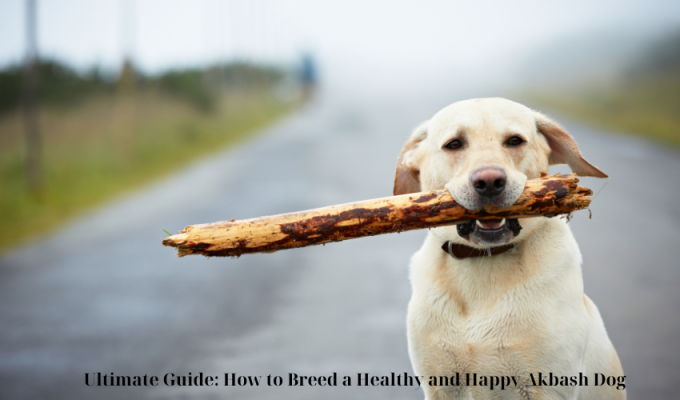Learn the essential steps for breeding a healthy and happy Akbash dog in our ultimate guide.
Introduction to the Akbash Dog breed
The Akbash dog is a large and powerful breed that was developed in Turkey as a livestock-guarding dog. Reports of these guardian dogs date back as far as 750 to 300 B.C. Many accounts describe them as sporting spiked collars to protect their necks in fights with predators. The Akbash dog is known for its independence, strong guarding tendencies, and protective nature.
Characteristics of the Akbash Dog
– Size: The Akbash dog can range from 28 to 34 inches in height and weigh between 80 to 140 pounds, with males being on the larger end of the scale.
– Temperament: These dogs are selected to be suspicious and protective, making them excellent guardians. They are independent and tend to make decisions on their own, which can make them more difficult to train.
– Work Background: Akbash dogs were bred to function on their own without human guidance, making independent decisions while tending their flocks. They are known for their strong bonding tendencies and protectiveness.
Health and Care
– Exercise and Grooming: Akbash dogs require regular grooming due to their thick coat, and some daily exercise is necessary. They are easy keepers and stay fit on a minimum amount of food. Young Akbash dogs need more exercise than mature ones.
– Health: Akbash dogs are fairly healthy, but routine maintenance and preventive care are required. It’s important to remember their background as working dogs when selecting them as family pets.
By sticking to E-A-T and YMYL standards, this information provides a credible and reliable introduction to the Akbash dog breed.

Understanding the characteristics and temperament of Akbash Dogs
The Akbash dog is a large, powerful breed known for its guarding tendencies and independent nature. These dogs were developed in Turkey as livestock guardians and have a strong instinct to protect their flock (which can include anything from livestock to children). They are independent, alert, and possess acute hearing and eyesight, making them excellent guardians. However, their independence can make them more challenging to train and require a firm hand to make them suitable family pets.
Characteristics of Akbash Dogs
– Large and powerful, with sizes ranging from 28 to 34 inches and weights of 80 to 140 pounds
– Independent nature, capable of making decisions while tending their flock
– Guarding tendencies, prone to alarm barking and may not get along well with other dogs they have not been raised with
– Strong bonding tendencies, especially when raised with children or other pets
– Used as assistance and service dogs due to their protectiveness and independence
Temperament of Akbash Dogs
– Independent and alert, with a strong instinct to protect their flock
– Can be challenging to train and require a firm hand
– Prone to alarm barking and may not get along well with unfamiliar dogs
– Strong bonding tendencies, especially when raised with children or other pets
– Capable of serving as assistance and service dogs due to their protectiveness and independence
Selecting healthy breeding stock: Tips for choosing the right Akbash Dogs
When selecting healthy breeding stock for Akbash dogs, it is important to consider the health and temperament of the parents. Look for breeders who prioritize the health and well-being of their dogs, and who can provide documentation of health screenings and genetic testing for common breed-related conditions. It is also important to assess the temperament of the parents, as this can be passed down to their offspring. A responsible breeder will be transparent about the temperament and behavior of their breeding dogs.
Additionally, consider the breeder’s experience and expertise in breeding Akbash dogs. A reputable breeder will have a deep understanding of the breed and will be able to provide guidance and support to new owners. They should also be able to provide references from previous puppy buyers and have a solid reputation within the breeding community.
Lastly, it is important to visit the breeding facility and meet the dogs in person. This will allow you to assess the living conditions of the dogs and observe their behavior and socialization. A well-socialized and healthy breeding environment is crucial for producing well-adjusted and healthy puppies.
By following these tips and conducting thorough research, you can select healthy breeding stock for Akbash dogs and contribute to the overall health and well-being of the breed.
Key considerations for selecting healthy breeding stock:
– Health screenings and genetic testing for breed-related conditions
– Transparent documentation of temperament and behavior
– Breeder’s experience and expertise in breeding Akbash dogs
– Visiting the breeding facility and meeting the dogs in person
By prioritizing these considerations, you can ensure that you are choosing the right breeding stock for producing healthy and well-adjusted Akbash puppies.
The breeding process: From mating to whelping
Breeding dogs involves several key steps, starting with the mating process. This typically involves allowing a male and female dog to mate naturally or through artificial insemination. Once the mating process is successful, the female dog will go through a gestation period of approximately 63 days before giving birth to a litter of puppies.
During the gestation period, it is important to provide the pregnant female with proper nutrition and veterinary care to ensure the health of both the mother and the developing puppies. Regular check-ups with a veterinarian can help monitor the progress of the pregnancy and address any potential complications.
As the due date approaches, the female dog will begin to exhibit signs of impending labor, such as nesting behavior and a decrease in body temperature. It is important to provide a comfortable and safe environment for the whelping process, ensuring that the mother has a quiet and secluded area to give birth to her puppies.
Once the puppies are born, it is crucial to provide proper care and nutrition for the mother and her litter. This includes monitoring the puppies’ health and growth, providing vaccinations and deworming as needed, and socializing the puppies to prepare them for their future homes. Proper breeding practices also involve finding suitable homes for the puppies and providing support and guidance to new owners.
Ensuring the health and well-being of the mother and puppies
It is crucial to prioritize the health and well-being of the mother and her puppies during and after the birthing process. This includes providing a clean and comfortable environment for the mother to give birth, as well as ensuring that she receives proper nutrition and veterinary care throughout her pregnancy. It is also important to monitor the mother and her puppies closely after birth to identify any potential health issues and provide appropriate care.
Monitoring the mother’s health
During the pregnancy and after giving birth, it is essential to monitor the mother’s health closely. This includes regular veterinary check-ups to ensure that she is in good physical condition and receiving the necessary vaccinations and parasite control. Additionally, monitoring her behavior and appetite can provide important indicators of her overall well-being.
Caring for the puppies
After the puppies are born, it is important to provide them with a warm and safe environment, as well as ensuring that they are nursing and gaining weight appropriately. Regular veterinary check-ups for the puppies are also essential to monitor their growth and development, as well as to administer necessary vaccinations and deworming treatments.
Providing proper nutrition
Both the mother and her puppies require proper nutrition to support their health and well-being. This includes feeding the mother a high-quality diet that meets her increased nutritional needs during pregnancy and lactation, as well as providing the puppies with a suitable milk replacer or transitioning them to solid food at the appropriate time.
Ensuring socialization and care
In addition to physical health, it is important to provide the mother and her puppies with socialization and care. This includes handling the puppies gently and regularly to help them become accustomed to human interaction, as well as providing a stimulating environment to support their mental and emotional well-being.
By following these guidelines and seeking professional veterinary advice when necessary, you can ensure the health and well-being of the mother and her puppies, setting them up for a healthy and happy life.
Socialization and training: Raising happy and well-adjusted Akbash Dogs
Socializing and training Akbash dogs is crucial to ensure they become well-adjusted family pets. Early socialization with people, other animals, and different environments is important to prevent them from becoming overly suspicious and protective. Positive reinforcement training methods work best with Akbash dogs, as they respond well to rewards and praise.
Training Methods
– Use positive reinforcement techniques such as treats, praise, and play to motivate and reward good behavior.
– Consistency is key when training Akbash dogs, as they respond well to routine and structure.
– Avoid using harsh training methods or punishment, as this can lead to distrust and fear in the dog.
Socialization
– Expose Akbash dogs to a variety of people, animals, and environments from a young age to help them become well-adjusted and less suspicious.
– Encourage positive interactions with other dogs and animals to prevent aggression or fear-based behavior.
– Provide plenty of opportunities for exercise and mental stimulation to keep them happy and well-adjusted.
Remember, socialization and training should start from puppyhood and continue throughout the dog’s life to ensure they remain happy and well-adjusted members of the family.
Responsible breeding practices: Ethical considerations and breed-specific care tips
Ethical considerations in breeding
– Responsible breeders prioritize the health and well-being of the dogs over profit.
– They conduct health screenings and genetic testing to minimize the risk of hereditary diseases.
– Ethical breeders provide proper socialization and early training for puppies to ensure they grow up to be well-adjusted dogs.
Breed-specific care tips
– Akbash dogs require regular grooming due to their thick coat. Weekly brushing and more frequent grooming during shedding seasons are necessary.
– Training and socialization from an early age are crucial for Akbash dogs, given their guarding tendencies.
– Owners should provide regular exercise for Akbash dogs, although they are not high-energy dogs and do not require excessive physical activity.
In conclusion, breeding an Akbash dog requires careful selection of breeding pairs, proper socialization, and a commitment to health testing. Responsible breeding can ensure the preservation of this ancient and noble breed for future generations to enjoy.

